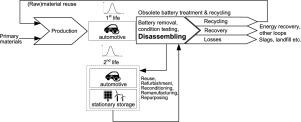Resources, Conservation and Recycling ( IF 11.2 ) Pub Date : 2021-06-27 , DOI: 10.1016/j.resconrec.2021.105735 Simon Glöser-Chahoud , Sandra Huster , Sonja Rosenberg , Sabri Baazouzi , Steffen Kiemel , Soumya Singh , Christian Schneider , Max Weeber , Robert Miehe , Frank Schultmann

|
Electro-mobility is considered a key strategy to reduce GHG emissions in the transport sector and to make individual mobility more sustainable. However, the production of electric vehicles is accompanied by high environmental impacts, mainly due to the resource intensive high-voltage battery systems. Hence, a prerequisite for sustainable electro-mobility – beside the provision of renewable energy for vehicle charging – is a well-functioning and efficient circular use system of electric vehicle battery systems (EVBs). While the production of EVBs has been continuously improved in recent years with high levels of automation to reduce production costs and to increase capacities, end-of-life (EoL) treatment of EVBs is still rather simplistic with rough manual disassembling before in most cases pyro-metallurgical treatment. In this paper, we argue for the need of industrial disassembly systems to reach higher levels of circularity. In the best case, these systems are highly automated and use lifecycle information including production and use-phase data for decision support to enable optimum utilization at a module or even cell level. These pathways include both second-life concepts such as repurposing or reconditioning and high-level direct recycling of active materials. To demonstrate the advantages of an industrial disassembling in EoL battery treatment, we systematically analyze different utilization pathways and we compare state-of-the-art treatment with an advanced disassembly system. The qualitative argumentation is substantiated by quantitative stochastic simulation as well as cost and lifecycle data. We show that only with a well-functioning industrial disassembling, efficient closed-loop-supply-chains (CLSCs) for EVBs can be achieved.
中文翻译:

工业拆解是淘汰电动汽车电池系统循环经济解决方案的关键推动因素
电动汽车被认为是减少交通部门温室气体排放并使个人出行更具可持续性的关键战略。然而,电动汽车的生产伴随着高环境影响,主要是由于资源密集型高压电池系统。因此,除了为车辆充电提供可再生能源之外,可持续电动汽车的先决条件是功能良好且高效的电动汽车电池系统 (EVB) 循环使用系统。虽然近年来 EVB 的生产不断改进,自动化水平高,以降低生产成本和增加产能,但在大多数情况下,EVB 的报废 (EoL) 处理仍然相当简单,需要粗略的手动拆卸-冶金处理。在本文中,我们认为工业拆卸系统需要达到更高的循环水平。在最好的情况下,这些系统是高度自动化的,并使用生命周期信息(包括生产和使用阶段数据)作为决策支持,以实现模块甚至单元级别的最佳利用。这些途径包括第二次生命概念,例如再利用或修复以及活性材料的高水平直接回收。为了展示工业拆解在 EoL 电池处理中的优势,我们系统地分析了不同的利用途径,并将最先进的处理与先进的拆解系统进行了比较。定性论证得到定量随机模拟以及成本和生命周期数据的证实。我们表明,只有运行良好的工业拆卸,











































 京公网安备 11010802027423号
京公网安备 11010802027423号